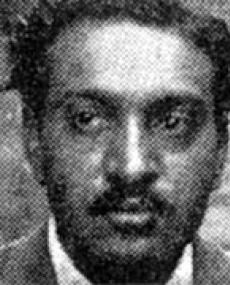
Suliman Moosa Esakjee was born in 1928. He worked as a clerk, and was an active member of the Transvaal Indian Congress (TIC) from its inception. He served as the Joint Secretary of the Transvaal Indian Youth Congress and the Joint Secretary of the Transvaal Indian Congress.
Esakjee played a major role in the formation of the Congress of the People (COP) which adopted the Freedom Charter in 1955. Esakjee was a member of the Johannesburg Regional Committee of the Congress of the People and Secretary of the Transvaal Action Committee in 1955. He also served as the Secretary of the Consultative Committee of the Congress of the People.
He served a term of imprisonment during the 1946 Passive Resistance Campaign and was also jailed for 30 days for his part in the 1952 Defiance Campaign against unjust laws. He stood trial with 155 others in the 1956 Treason Trial, which continued until March 1961. Charges against him were withdrawn in January 1958.
Of the five regional COP committees, the Johannesburg Central Regional Committee was the most active and organised. Serving on the committee were Esakjee, 'Mervie' Thandray, F Adams, M. Goldberg, June Shabangu, P. Mathole, F. Morris, Sophie Williams and L. Morrison. The COP bulletin Speaking Together,described the activities of volunteers as follows:
"Reggie Vandeyar and Suliman Esakjee, both TIC activists, recounted that 'extensive work' was done by the TIC in Fordsburg, Vrededorp, Doornfontein, Alexandra Township, Jeppe, Malay Camp, Asiatic Bazaar/ Pretoria, Sophiatown, Newclare, Martindale, Benoni, Nigel, Springs, Germiston, Kliptown, Denver, Newlands, Turfontein, Ophirton, and in Coronationville, Noordgesig and Albertsville with SACPO. Initially groups of volunteers would go out to distribute 'advanced propaganda' and to discuss the campaign with residents on a house-to-house basis".
Thereafter, depending on the strength of the organisation in the area, a public meeting or house meeting would be convened to elaborate on the campaign, to explain what was expected from the people and to emphasise the need for direct participation of the people in the campaign either as volunteers, or by the submitting of demands and the election of delegates. These meetings often discussed political issues of the day such as the introduction of Bantu Education, the threat of removals from Western Areas and local grievances.
Esakjee recalls the link between the COP campaign and the Anti-Western Areas Removal Campaign:
" ... (at) that time there was a big uproar about the removal of Sophiatown. The people being under the threat of being removed made more demands. First of all, the demand, 'we don't want to be moved'. We combined both campaigns". David Mahopo, a Sophiatown resident at the time, corroborated this viewpoint: "In Sophiatown, we were organising by street... and telling them about the COP and collecting demands. We have leaders in every street. They first go to each house. After that they call a meeting in a certain house in a street. They get demands at these meetings."
However, the Congress movement failed to defend the people of Sophiatown and provide effective action-orientated leadership in the face of enforced removals. This failure prompted the following honest, self-critical assessment of the Anti-Western Areas Removal Campaign from the NAC:
“... [the Congresses] at no stage managed successfully to link the COP with the day-to-Âday struggles of the people. Had we worked properly in this regard the campaign, e.g., against the removal scheme, instead of bringing the COP to a virtual standstill in the Transvaal, would have raised it to greater heights".
On the issue of women, Esakjee also recalls 'group meetings of Indian women' having been organised to discuss the COP. Similarly, Helen Joseph had invited an unspecified 'women's committee... [to] hold a house meeting', where a Federation of South African Women (FEDSAW) speaker would speak about the COP, and a delegate would be elected to represent them.
Esakjee was also involved in the Picasso Club, which painted anti-apartheid graffiti on walls. Other members included Ahmed Kathrada, Babla Saloojee, Herbie Pillay, Mosie Moolla and Faried Adams. He was convicted for painting Freedom Charter slogans in 1955.
Esakjee was banned in terms of Act No. 44 of 1950 Sec. 9 (1), which was served on him on 28 April 1967. The banning order was due to expire on the 31 January 1969.
Suliman “Solly” Esakjee died in hospital on 1 February 2009. He was 79 and is survived by two daughters and two sons.